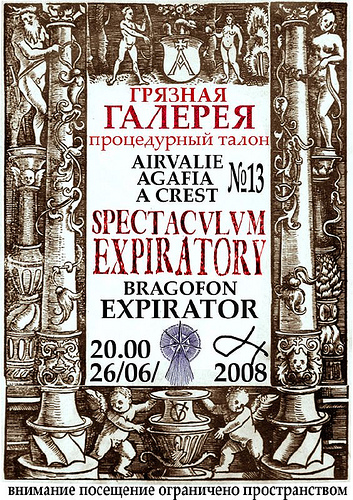Gryaznaya gallery, St.Petersburg
Thursday 26.06.2008, at 20.00
airvalie /agafia/mikhael a crest sator ArXeNeKrOHeN (beautiful)
are working in circus theatre of Gryaznaya gallery in:
~ BRAGOPHONE EXPIRATOR ~
Cyland Medialab & Anna Frants cordially invites you to attend performance “spectaculum expiratory” that will take place at Gryaznaya gallery in St.Petersburg, Russia on Thursday, June 26th, 2008. This performance precedes the “Sonicself” exhibition opening July 17th at Chelsea Museum (New York).

Main point of Audio Performance. Bragophone EXPIRATOR, latest from the great number of bragophones, created in Gryaznaya gallery, illustrates qualities of laboratory media theory, peculiar to boundary states of process’ initiators uncontrolled creative work. Direct audio broadcast of inner fermentation process will be provided, using built-in expiration module.
+bragofon |expirator|
Audio installation of crisscross pneumo-hydrodynamic effects

Technical description
Bragophone is a pneumatic device of sound extraction based on the expediency of hydraulic seal (air separation) in the process of alcohol fermentation under anaerobic conditions. period of the bragophone’s active functions is about five days, after which yeast fungi gradually lose activity and die on the thirteenth day due to the inability to exist in the alcohol that they had produced.
The reservoir with water solution of sugar and yeast (“home-brew“ or “braga“) is equipped with a module for throttling of streams of carbon dioxide in ducts towards terminals that are located in two hydro acoustical resonators. the terminals that emit bubbles of carbon dioxide by batches into the water create an underwater and above water acoustic resonance that is registered by the microphones.
in the process of transformation of electric signals that come from microphones installed in the hydro acoustical resonators into oscillative motions of the system of pneumo-hydrodynamic expiration, a membrane, set in motion by electric magnets that go off simultaneously with audio registration, creates a pneumatic jolt, the “expiration” in the reservoir generating the pressure of carbon dioxide, by displacing the permanent pressure of the released gas with its exhaustion and a jolt of the membrane returning into its initial position, which accordingly changes the emission of bubbles by batches and the general background of audio effects by closing them on their own resonance.
Ethanol fermentation
term “fermentation” was implemented by flemish alchemist Jan Baptista van Helmont in XVII century for the processes with gases excretion.
ethanol fermentation is the biological process by which sugars such as glucose, fructose, and sucrose, are converted into cellular energy and thereby producing ethanol, and carbon dioxide as metabolic waste products. yeasts carry out ethanol fermentation on sugars in the absence of oxygen. because the process does not require oxygen, ethanol fermentation is classified as anaerobic. ethanol fermentation is responsible for the rising of bread dough, the production of ethanol in alcoholic beverages, and for much of the production of ethanol for use as fuel.
the chemical equation below summarizes ethanol fermentation, in which one hexose molecule is converted into two ethanol molecules and two carbon dioxide molecules:
C6H12O6 → 2 C2H5OH + 2 CO2
anaerobic – (from greek an – without + aer air + bios life + – ikos of, relating to, or resembling)
expiration (lat. expiro, to breathe out)
expiration (the act of forcing air out of the lungs.)
_______________________________________________________________
Bundling
– one 20 liters large bottle with jet module and knob-reliquarium-inhaler, including suspended module of expirator and pedestal
– two 20 liters large resonator bottles
– terminators and tubes
– 5 kilograms of sugar, 500 grams of yeasts and 15 liters of water
– electricity 220 V
Installation is fire-safe and do not excrete toxic gases
Carbon dioxide is not toxic, but do not support breathing. it is used to create protective atmosphere for welding, in food industry to produce carbonated soft drinks, “dry ice”, during the transportation and storage of ice cream and other frozen foods; to dry casting forms; for fire fighting and other industrial purposes. carbon dioxide is produced by all animals, plants, fungi and microorganisms during respiration and is used by plants during photosynthesis. it forms approximately 0.04% of the earth’s atmosphere.
